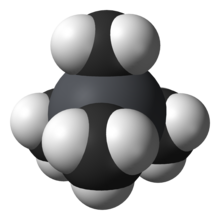
| |

| |
| Names | |
|---|---|
| Other names Tetramethylplumbane | |
| Identifiers | |
| CAS Number | |
| 3D model (JSmol) | |
| ChEBI | |
| ChemSpider | |
| ECHA InfoCard | 100.000.816 |
| EC Number |
|
| PubChem CID | |
| RTECS number |
|
| UNII | |
| UN number | 1649 3082 |
| CompTox Dashboard (EPA) | |
InChI
| |
SMILES
| |
| Properties | |
| Chemical formula | C4H12Pb |
| Molar mass | 267.3 g·mol |
| Hazards | |
| GHS labelling: | |
| Pictograms |     
|
| Signal word | Warning |
| Hazard statements | H226, H300, H302, H310, H332, H360, H373, H410 |
| Precautionary statements | P201, P202, P210, P233, P240, P241, P242, P243, P260, P261, P262, P264, P270, P271, P273, P280, P281, P284, P301+P310, P301+P312, P302+P350, P303+P361+P353, P304+P312, P304+P340, P308+P313, P310, P312, P314, P320, P321, P322, P330, P361, P363, P370+P378, P391, P403+P233, P403+P235, P405, P501 |
| NFPA 704 (fire diamond) |
 |
| Flash point | 37.8 °C (100.0 °F; 310.9 K) closed cup |
| Related compounds | |
| Related compounds | |
| Except where otherwise noted, data are given for materials in their standard state (at 25 °C , 100 kPa). Infobox references | |
Tetramethyllead, also called tetra methyllead and lead tetramethyl, is a chemical compound used as an antiknock additive for gasoline. Its use is being phased out for environmental considerations.
The National Institute for Occupational Safety and Health (NIOSH) in the United States has identified tetramethyllead as a potential workplace hazard. The recommended time-weighted average exposure limit to tetramethyllead is 0.075 milligrams per cubic meter during a 10-hour workday; the OSHA permissible exposure limit is the same value assuming an 8-hour workday.
Exposure to tetramethyllead can affect the central nervous system, the kidneys, and the cardiovascular system. Tetramethyllead can be absorbed through inhalation, through eye contact, through skin absorption, and by ingesting the substance. Symptoms of exposure include insomnia, coma, seizure, mania, delirium, loss of appetite, nausea, hypotension, anxiety, restlessness, and nightmares. First aid measures for exposure include artificial respiration, immediate eye irrigation, and immediate washing with water. Immediate medical attention should be sought if tetramethyllead is ingested.
See also
References
- "Tetramethyllead". pubchem.ncbi.nlm.nih.gov.
- Filella, Montserrat; Bonet, Josep (2017). "Chapter 14. Environmental Impact of Alkyl Lead(IV) Derivatives: Perspective after Their Phase-out". In Astrid, S.; Helmut, S.; Sigel, R. K. O. (eds.). Lead: Its Effects on Environment and Health. Metal Ions in Life Sciences. Vol. 17. de Gruyter. pp. 471–490. doi:10.1515/9783110434330-014. PMID 28731307.
- "CDC - NIOSH Pocket Guide to Chemical Hazards - Tetramethyl lead (as Pb)". www.cdc.gov. Retrieved 2016-06-07.